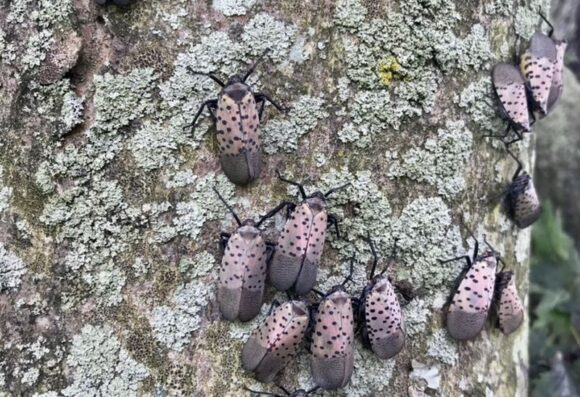
Spotted Lanterflies. Courtesy of Anne Nielsen.
Rutgers entomologists explain what may have happened to the invasive species in New Jersey
Students strolling through Busch campus at Rutgers University–New Brunswick last fall were greeted by a slew of spotted lanternflies – invasive insects who huddled outside of the Richard Weeks Hall of Engineering and other buildings like anxious, early morning shoppers on Black Friday.
So far this season, the bugs – who in past years made local headlines and were the subject of a pub crawl in Bordentown – don’t seem to be around as much in some parts of New Jersey.
What happened to the spotted lanternflies, whose destructive-to-plants tendencies have drawn concern from state officials and the agricultural industry?
Two Rutgers entomologists – George Hamilton, an Extension Specialist in Pest Management with the Department of Entomology at the School of Environmental and Biological Sciences, and Anne Nielsen, an Associate Extension Specialist in Entomology – provided some insights on why these winged invaders seem to be in far fewer numbers around these parts this season.

George Hamilton is an Extension Specialist in Pest Management with the Department of Entomology at the School of Environmental and Biological Sciences.
Courtesy of George Hamilton.
Where are the spotted lanternflies in New Jersey this season? What’s happened to them?
Hamilton: They are pretty much distributed throughout the state and the whole state is now under quarantine. Having said that, in many areas the numbers are lower than they have been the last two years. The reasons are unclear.
Possible reasons could be the hot dry weather we had last summer, the severe cold we had in January or the relatively warm weather we had during most of the winter. It could also be that the high populations have severely damaged or killed their host plants causing them to move on.
What factors might be affecting spotted lanternfly populations in the state? Has nature evolved to combat these invasive insects?
Hamilton: Possibilities include climatic factors, natural predation and parasitism (although at low levels), disease and human actions.
Have we learned anything new about spotted lanternflies since their arrival to the state? Anything surprising?

Anne Nielsen is an Associate Extension Specialist in Entomology at Rutgers–New Brunswick. Courtesy of Anne Nielsen.
Nielsen: The spotted lanternfly has a wider host range than we initially expected, but it includes mostly hardwood trees. Most significantly, the spotted lanternfly’s impact to agriculture has not been as widespread as initially predicted. We are seeing impacts to grape production and some nursery crops, but agricultural impacts are mostly limited to these commodities.
Where are spotted lanternflies now in their growth-cycle stage?
Hamilton: Populations for the most part are now adults, however fourth instars (red, black and white individuals) can still be found.
How are we dealing with spotted lanternflies? How do we counteract their presence?
Nielsen: There are multiple approaches to combating the spotted lanternfly. The New Jersey Department of Agriculture established a quarantine early in its detection in the state. This allowed them to selectively treat tree of heaven, a preferred host plant, and distribute information to the general public to reduce human-aided movement.
To manage the pest long-term, we will need a multi-life stage approach that likely includes trapping for the nymphal stages on preferred host trees like the red maple, black walnut and tree of heaven. The United States Department of Agriculture-developed circle trap is easy to make and can remove thousands of young nymphs. Adult management likely requires insecticide treatment by trained professionals on hardwood trees and by commercial grape growers. Scraping of egg masses may help but will only remove about 10 percent to 20 percent of eggs on a tree.
Long-term solutions will include biological control with species that target lanternflies after more research and screening is conducted.
This article originally appeared in Rutgers Today.

